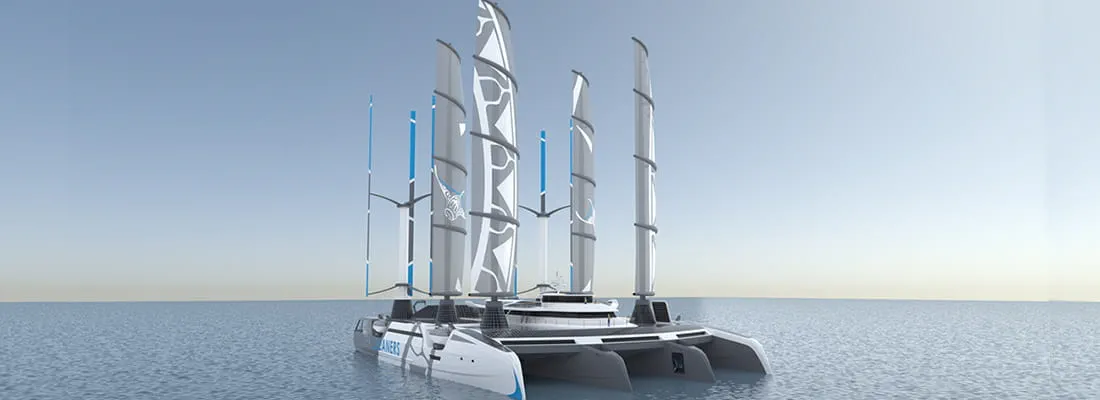As we have mentioned in previous articles, there is an ever-growing amount of creative activity being undertaken by sea loving individuals, many of them yachtsmen, towards cleaning up the oceans for future generations.
Visiting the Marina High Tech show in the South of France last month, we came across another fascinating and ambitious project which is under development, and moving towards its implementation phase.
Read an update on the Sea Cleaners Manta Project and EU focus on cleaner oceans.
The Sea Cleaners (Manta Project)
The brainchild of French skipper, adventurer and ecologist, Yvan Bourgnon, The Manta, described as a ‘revolutionary factory ship’ is based upon a massive purpose designed, plastic collecting vessel with four hulls. She will have a deck area the size of a football pitch, and masts higher than the Eiffel Tower according to her design team.
Bourgnon says, “I first sailed around the world with my parents when I was eight years old. Since then I have participated in many ocean races around the world, and I have been shocked by the amount of plastic waste polluting the seas.”
“This awareness of the global catastrophe affecting our planet, prompted me to create the association called ‘The Sea Cleaners’ in September 2016, its purpose is to fight ocean plastic pollution. To face this new challenge, I surrounded myself with experts and professionals in this field, in order to find an innovative solution.”
A uniquely conceived design and operational function
The Manta will use state-of-the-art tools to remove the floating plastic macro-waste before it gets degraded, and begins to irreversibly pollute the marine enviroment. She will have a fully operational factory on board to collect, sort, compact and store plastic waste.Three collecting treadmills will be installed between the hulls of the ship to quickly pull up big quantities of plastics. The Manta will be able to store more than 250 tons of waste, compacted into 1m3 bales in its hulls, before transferring them on the land, where the waste will be handled by adapted recycling centers.
Two powerful cranes will also be deployed to remove larger floating debris from the water, such as nets or containers lost by other vessels or debris from the land. This can be stored onboard before destruction on land in specialised units.
Totally autonomous and ecologically driven
The vessel is designed to use the minimum amount of carbon producing energy. With the latest battery storage technology onboard, and a hybrid propulsion system, involving a proven ‘Dyna Rig’ sail construction and electric motors, the Manta will have the maximum autonomy for its travel and collection phases. She will also utilise 2000 m² of solar panels and 2 Darrieus wind turbines producing 1 Mw of clean energy.
Just-in-time deployment, at the source!
The Manta will be able to be deployed anywhere across the world, rapidly reaching the zones of densest pollution, whether these are along coasts, in estuaries, or on the high seas, enabling the collection of floating macro plastic waste before it sinks to the bottom of the sea.
The feasibility studies are all completed, and a shipyard is now being sought to build her in France according to the team put together by Bourgnon, who were enthusiastically represented on the stand at the Marina High Tech show.
They explained that the project milestones are in place to have the boat built by 2021, and that she will be collecting plastic waste from the oceans in Asia by 2022. The plan is to operate close to the mouths of the great rivers, from where most of the plastic pollution flows into the sea.
Marine life protection and ‘big data’ enabled
During its collection phases, travelling at around 2 knots, the Manta will be equipped with an audio emission system, this will divert cetaceans and other fish from its route, thus preventing them from being captured accidentally.
To improve knowledge and reinforce the prevention of pollution, the vessel will also have a complete scientific laboratory onboard, this will enable the waste to be studied in terms of geolocation, quantity and quality. The data will then be provided to the entire international community on an open source basis.
More details: www.theseacleaners.org

